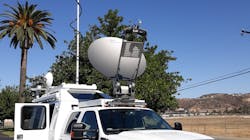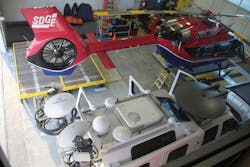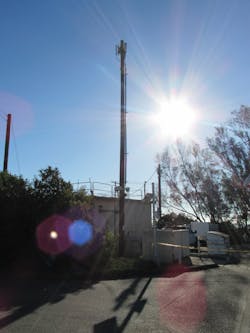More than half of the largest wildfires in California’s history have occurred in the past two years, and research has shown drier conditions have increased significantly the risk and scale of wildfires worldwide. In the Western U.S., which is suffering from record drought conditions, the wildfire season is now year-round.
Launched in 2007, San Diego Gas & Electric Co.’s (SDG&E’s) wildfire prevention program deploys a range of technologies and solutions to help protect communities within its service territory, especially those in remote areas subject to extreme weather and increased wildfire risk. One of the utility’s recent innovations in wildfire mitigation is its distribution communications reliability improvements (DCRI) project, which includes building a 5G-ready private broadband communications network.
Nearly four years ago, the SDG&E network team was presented with the challenge of how to continue expanding its wireless network infrastructure to support emerging electric system protection technologies in a fast, effective and reliable manner. Unfortunately, traditional network platforms, including the utility’s legacy network platforms, were no longer a feasible option because they were built for single use cases and did not deliver the high-speed capacity and coverage required to meet the growing needs of the utility. Rather than leverage public networks provided by commercial carriers, SDG&E made the decision to develop its own private network.
Working Together
A network team began mapping out requirements and testing different technologies. Following months of analysis, consideration and extensive research on potential solutions within and outside the utility industry, including other utilities and the Utility Broadband Alliance, a private broadband communications network was identified as the best technology platform to meet SDG&E’s evolving needs.
Emerging use cases, such as falling conductor protection, require the transmission of large amounts of data. While some of the utility’s traditional networks can support a targeted transmission of PMU [phasor measurement unit] data, the wide adoption of its falling conductor application can no longer be supported effectively by the current traditional networks.
The DCRI project team partnered with several internal teams to gather and assess requirements and develop test scenarios for the new network technology platform. Once completed, the project team then connected with the utility’s system protection and engineering team as well as its technology partner, Nokia, to lab test and implement the core technology.
Encountering Challenges
A noteworthy challenge the team encountered was merging core competencies, such as electric infrastructure design, engineering and construction, with the implementation of a new technology platform. This means the technology team collaborated extensively with business units across the organization to jointly develop the appropriate standards for the new platform.
Another challenge was related to providing high-speed data transmission reliably. With a private network, traffic for the falling conductor protection application and other business-critical communications could be identified upon entry to the network and given priority treatment end to end. SDG&E would own and operate the network, which means the utility could engineer the configurations according to its business needs.
The Benefits Of Private
SDG&E’s private broadband communications network was engineered to meet the mission-critical needs of the utility and enhance the safety and reliability of its infrastructure. It is scalable to adapt to new and emerging business use cases and requirements. Developing a private network affords SDG&E the ability to prioritize and transfer data at high speed, without interruption. Therefore, during times of high data congestion or system emergencies, the utility does not need to wait in the data transfer queues of commercial carriers, nor is the utility impacted when commercial carrier networks are congested or not available.
The private network is made up of a base station radio site located throughout SDG&E’s service territory, providing wireless coverage to end points on the power system. Network traffic sent from an end point traverses the base station and is backhauled to one of the two georedundant data center network cores,
responsible for routing traffic to its destination.
When talking about wildfire mitigation, every second counts, which is why the utility couldn’t afford traditional network delays. Having its own private broadband communications network gives it the ability to monitor and maintain the energy grid in real time when it matters most. An additional benefit of having a private communications network is the need to focus on data upload rather than download. Traditional carrier solutions are built to support data consumption; however,
SDG&E’s use cases are focused on uploading and sending data to its systems to take appropriate actions (for example, deenergizing falling conductor). This design requirement was another consideration the network team took into account when choosing the technology platform.
Emerging Use Cases
SDG&E operates several proprietary private wireless communications networks to support mission-critical applications that provide supervision and collect data across the utility, efficiently manage distributed energy resources such as solar panels and battery systems, and control microgrids. The DCRI project has enabled the utility to consolidate its proprietary private wireless networks for greater operational efficiency and improved cybersecurity, and has also facilitated the rollout of new safety systems, like SDG&E’s patented distribution falling conductor protection system, which requires the quick transmission of large amounts of data while maintaining high network reliability.
Falling conductor protection technology works by cutting off power to a falling power line within approximately 1.37 sec — before it hits the ground, thereby avoiding possible ignitions with dry vegetation and other flammable materials. SDG&E’s engineers created this technology by collecting and analyzing data across its smart power grid to develop an algorithm that works with sensors to detect a falling power line and deenergize it immediately. The technology requires network speeds of 50 msec to 100 msec to operate effectively, and the DCRI project will support its complete rollout following successful field-testing in fire-prone areas of San Diego County.
In addition to supporting the DFCP system, the network can be expanded to use a fault location, isolation and service restoration (FLISR) system, which can reduce the number of SDG&E customers impacted by a fault, by automatically isolating the fault and quickly restoring power to customers by transferring them to other circuits.
SDG&E also is evaluating the communications capabilities of its private network by supporting a mobile workforce use case. Typically, cellular service and radio transmissions can be spotty in eastern San Diego County because of the mountainous topography. Thus, SDG&E crews need a reliable communications network to not only communicate with team members on the ground but also access information by a mobile device, tablet or laptop. The private broadband communications network can solve this problem while offering enhanced information security because of the secure connections, which only allow authorized users on the system. The utility is currently evaluating and piloting more than 15 use cases for the private broadband network, including distribution supervisory control and data acquisition and smart meter backhaul. The network also can serve as the backbone for effectively managing a modern grid, as more DERs such as microgrids, energy storage and EVs add greater complexity.
Wildfire Mitigation Plan
The development and deployment of a private broadband communications network is just one of many wildfire resiliency programs included in SDG&E’s wildfire mitigation plan filed with the California Public Utilities Commission each year. In accordance with the state’s Senate Bill 901, the wildfire mitigation plan outlines the ongoing practices and additional improvements SDG&E will make beyond the investments it has made already to combat the effects of the threat of year-round wildfires.
Omar Zevallos P.E., is a senior group product manager in SDG&E’s cloud and infrastructure division. Zevallos has responsibility for all components of the network technologies used at SDG&E. His organization includes the architecture and engineering teams for the data center and enterprise networks, the network operations center, including field technical support, and the operations technology team, which supports SDG&E’s mission-critical networks. A professional engineer licensed in California, he has an MS in Leadership degree from Norwich University and a BSEE degree from San Diego State University. Zevallos started his career in the T&D engineering division, supporting field operations and engineering. Then he transitioned into project management, helping with the implementation of the utility’s smart meter project, microgrid and outage management system/distribution management system replacement. He moved to the IT division in 2018, leading the implementation of large infrastructure programs such as SDG&E’s land mobile radio refresh and distribution communications reliability improvements program.
The SDG&E OT Engineering team charged with the deployment of the DCRI program include Sr. Domain Architect Caleb D. Murphy, Principal Domain Engineer Michael R. Sanderson, Principal Domain Engineer Aaron M. Gray, Principal Domain Engineer Ali S. Atoui, Sr. Domain Engineer Amit K. Malik and Domain Engineer Kenneth L. Jaquish.
For More Information
Nokia | www.nokia.com
Key Facts
DCRI Project Details
Start: 2018
Full rollout expected: 2027
Purpose: Expand wireless network infrastructure to support emerging electric system protection technologies in a fast, effective and highly reliable manner
Key use cases:
l Falling conductor protection
l Distribution supervisory control and data acquisition
l Mobile workforce
l Smart meter backhaul
Potential use cases:
l Microgrid integration
l DER implementation
l Smart inverter communications
l Electric vehicle charging stations
l FLISR
l Wireless fault indicators
l Other grid-sensing technologies
About the Author
Omar Zevallos
Omar Zevallos ([email protected]), P.E., is a senior group product manager in San Diego Gas & Electric Co.’s (SDG&E’s) cloud and infrastructure division. Currently, Zevallos has responsibility for all components of the network technologies used at SDG&E. His organization includes the architecture and engineering teams for the data center and enterprise networks, the network operations center, including field technical support, and the operations technology (OT) team, which supports all of SDG&E’s mission-critical networks. A professional engineer licensed in California, he has a MSEE degree from Norwich University and a BSEE degree from San Diego State University. Zevallos started his career in the T&D engineering division, supporting field operations and engineering. Then he transitioned into project management, helping with the implementation of the utility’s smart meter project, microgrid and outage management system/distribution management system (OMS/DMS) replacement. He moved to the IT division in 2018, leading the implementation of large infrastructure programs such as SDG&E’s land mobile radio (LMR) refresh and distribution communications reliability improvements program.



